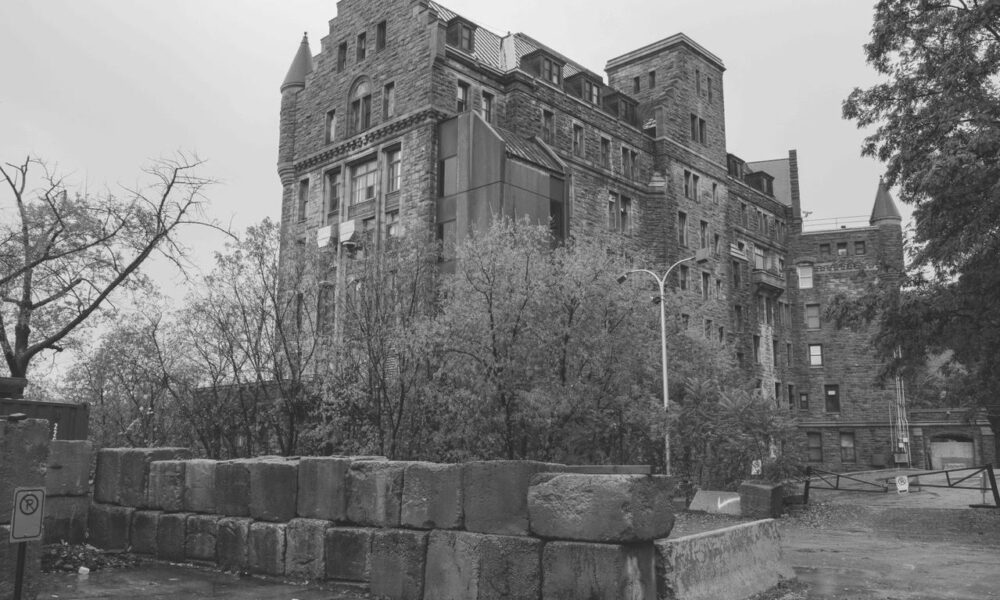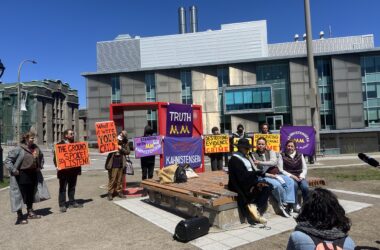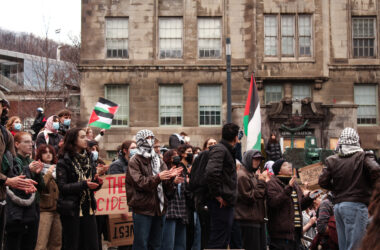Kahentinetha, a Kanien’kehá:ka kahnistensera (Mohawk Mother) of the Bear Clan and founder of Mohawk Nation News, is demanding the suspension of McGill’s New Vic project. In a brief posted to the Mohawk Nation News website, Kahentinetha called on McGill to acknowledge Indigenous sovereignty and to allow an investigation team—comprised of a surveyor, geologist, search dog, all guided by GeoView Pro software—to search for unmarked graves she suspects may be on the project site.
In the Mohawk Nation News post, Kahentinetha argued that because the Royal Victoria Hospital site sits on unceded Kanien’kehá:ka territory, the kaia’nere:kowa (The Great Law of Peace), pre-colonial Mohawk law, applies. Under this law, the Kanien’kehá:ka kahnistensera are caretakers of the land, and all decisions regarding it must be made with their consent. Additionally, Kahentinetha claimed that the Canadian government held money from the Iroquois Trust Fund, loaned it to McGill Universityin 1847, and never paid it back.
According to a McGill media relations officer Frédérique Mazerolle, McGill’s Indigenous Initiatives Unit and the Indigenous-owned consulting firm Acosys aimed to include Indigenous peoples in producing the project’s design.
“There have been several exchanges, including information sessions and round table discussions with Indigenous education organizations, Mohawk alumni, and Elders,” Mazerolle wrote in an email to The McGill Tribune.
In an interview with the Tribune, Kahentinetha argued that the land should be treated as an archeological site until further investigations are completed.
“[Rumours of unmarked graves on the property] are becoming more and more serious, so we would like that investigated,” Kahentinetha said. “And certainly there are our people buried up there in pre-colonial times, and we want that investigated as well. Nothing can proceed until that is done [….] If there’s going to be any investigation, we want to be involved with that. We want it done to our satisfaction.”
Kahentinetha believes McGill’s exchanges with Indigenous peoples should go beyond discussions with select community representatives, and should instead look to gain the consent of each member of the community, according to structures of Indigenous law.
“I do not think any one of [the Indigenous groups and representatives consulted] lives by the Great Peace,” Kahentinetha said. “We do not want consultation. You have to get our permission, and our permission we get from the Great Law [….] Each one of us has to have a say in whatever the decision is. Each one of us. Nobody speaks for us.”
In the 1950s and 60s, Dr. Donald Ewen Cameron experimented with torture techniques at the Allan Memorial Institute, a former psychiatric hospital next to the old Royal Victoria building. One Mohawk Nation News article features an interview with Lana Ponting, a survivor of these experiments, who says, “I am convinced that there are bodies buried in the property in the interview [….] I was really concerned about Indigenous peoples. I firmly believe that some of them were in the Allan.”
Kahentinetha, too, wants to send a forensic and archeological team to search for the bodies of potential Indigenous and non-Indigenous victims of Cameron’s experiments.
Public consultation on the New Vic project is ongoing. The rotisken’raketeh (Men’s Council Fire) will present Kahentinetha’s brief to the Office de consultation publique de Montréal (OCPM) on Nov. 10.
Mazerolle did not specify whether McGill would change the direction of the project to investigate human remains, pointing to prior studies conducted onsite.
“McGill commissioned a study on the archeological potential of the Royal Victoria Hospital site in 2016,” Mazerolle wrote. “According to this study, it is unlikely that Indigenous remains will be found on the New Vic Project site. However, McGill remains committed to collaborating with the government and First Nations communities regarding potential vestiges. Should such vestiges be found, it will be made public immediately, the work will be suspended, and an archaeological officer of the Minister of Culture and Communications will be alerted (as stated in the Cultural Heritage Act.1).”
While the study Mazerolle references determined that pre-colonial Indigenous settlement on the project site was unlikely, it also states there is no way to confidently know whether it was a burial site, unless human remains are found.
McGill plans to begin construction on the New Vic in 2023.









Thank you for your coverage of this important story. Please note that the rear of the AMI was cited in a 2008 report as a potential site of graves, including a specific reference to a stone wall. Here is a link to that report: http://archives.algomau.ca/main/sites/default/files/2010-061_015_024.pdf. I agree that the 2016 archaeology report invited further investigation (see p 71).